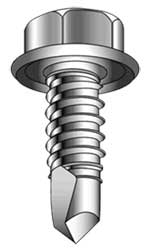Thread-forming screws and thread cutting screws for plastic are the two categories that make up the self-tapping screw category. The requirements of the application, as well as the kind of material and its characteristics, will guide the choice of screws for plastic.
Many designs have been patented and registered by different corporations. All of the manufacturers provide a variety of alternatives with varying thread profile angles, ranging from 30 to 45 to 48 degrees, to accommodate a wide range of polymers’ flexural moduli.
Thread Forming Screws for Plastic
Plastic thread-forming screws do not have a pointed tip. Therefore you need to drill a hole before using them. The plastic substance is deformed by the screw thread so that it may flow around the screw threads. Therefore, the amount of overlap, also known as thread engagement, and the angle of the thread profile are significant.
Thread-forming screws produce high internal stresses because the material is deformed rather than removed throughout the process. As a direct consequence, these screws are only appropriate for use in flexible polymers with a low flexural modulus.
Thread Cutting Screws for Plastic
As they are screwed into the pilot hole to create a threaded junction, best thread cutting screws for plastic have a sharp cutting edge that slices the plastic. Compared to thread-forming screws, this results in lower internal stresses, making them ideal for tougher plastic materials with higher flexural modulus. The diameter and depth of the pilot hole must be accurate.
The hole depth must be more than the screw engagement length to provide the removed material room to move. These allow strong thread engagement, high clamp loads, and decreased stress for polymers with fiber or glass fillings. Thread stripping during disassembly is the thread cutting screw’s main flaw.








